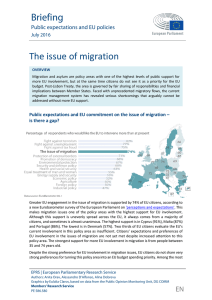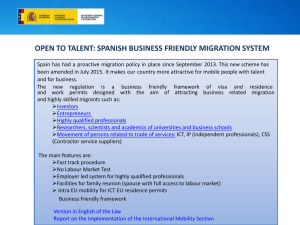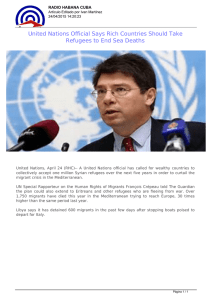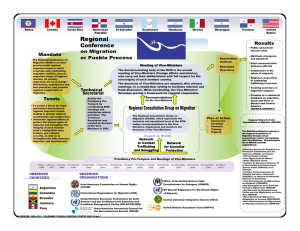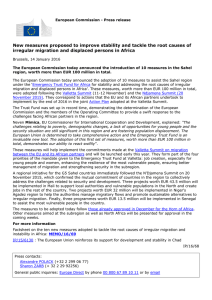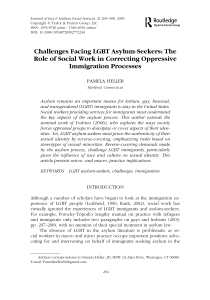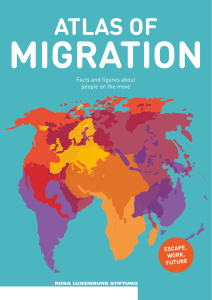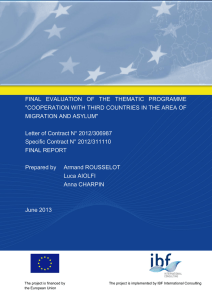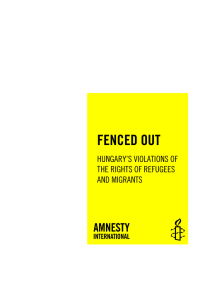MEMO - Europa
Anuncio
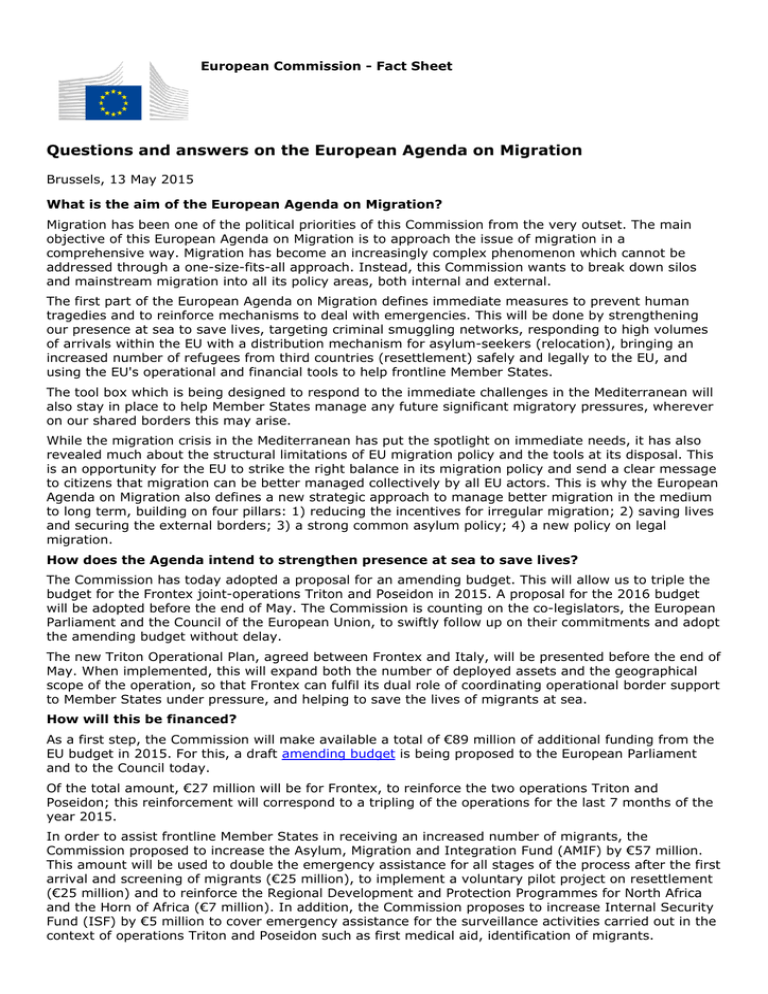
European Commission - Fact Sheet Questions and answers on the European Agenda on Migration Brussels, 13 May 2015 What is the aim of the European Agenda on Migration? Migration has been one of the political priorities of this Commission from the very outset. The main objective of this European Agenda on Migration is to approach the issue of migration in a comprehensive way. Migration has become an increasingly complex phenomenon which cannot be addressed through a one-size-fits-all approach. Instead, this Commission wants to break down silos and mainstream migration into all its policy areas, both internal and external. The first part of the European Agenda on Migration defines immediate measures to prevent human tragedies and to reinforce mechanisms to deal with emergencies. This will be done by strengthening our presence at sea to save lives, targeting criminal smuggling networks, responding to high volumes of arrivals within the EU with a distribution mechanism for asylum-seekers (relocation), bringing an increased number of refugees from third countries (resettlement) safely and legally to the EU, and using the EU's operational and financial tools to help frontline Member States. The tool box which is being designed to respond to the immediate challenges in the Mediterranean will also stay in place to help Member States manage any future significant migratory pressures, wherever on our shared borders this may arise. While the migration crisis in the Mediterranean has put the spotlight on immediate needs, it has also revealed much about the structural limitations of EU migration policy and the tools at its disposal. This is an opportunity for the EU to strike the right balance in its migration policy and send a clear message to citizens that migration can be better managed collectively by all EU actors. This is why the European Agenda on Migration also defines a new strategic approach to manage better migration in the medium to long term, building on four pillars: 1) reducing the incentives for irregular migration; 2) saving lives and securing the external borders; 3) a strong common asylum policy; 4) a new policy on legal migration. How does the Agenda intend to strengthen presence at sea to save lives? The Commission has today adopted a proposal for an amending budget. This will allow us to triple the budget for the Frontex joint-operations Triton and Poseidon in 2015. A proposal for the 2016 budget will be adopted before the end of May. The Commission is counting on the co-legislators, the European Parliament and the Council of the European Union, to swiftly follow up on their commitments and adopt the amending budget without delay. The new Triton Operational Plan, agreed between Frontex and Italy, will be presented before the end of May. When implemented, this will expand both the number of deployed assets and the geographical scope of the operation, so that Frontex can fulfil its dual role of coordinating operational border support to Member States under pressure, and helping to save the lives of migrants at sea. How will this be financed? As a first step, the Commission will make available a total of €89 million of additional funding from the EU budget in 2015. For this, a draft amending budget is being proposed to the European Parliament and to the Council today. Of the total amount, €27 million will be for Frontex, to reinforce the two operations Triton and Poseidon; this reinforcement will correspond to a tripling of the operations for the last 7 months of the year 2015. In order to assist frontline Member States in receiving an increased number of migrants, the Commission proposed to increase the Asylum, Migration and Integration Fund (AMIF) by €57 million. This amount will be used to double the emergency assistance for all stages of the process after the first arrival and screening of migrants (€25 million), to implement a voluntary pilot project on resettlement (€25 million) and to reinforce the Regional Development and Protection Programmes for North Africa and the Horn of Africa (€7 million). In addition, the Commission proposes to increase Internal Security Fund (ISF) by €5 million to cover emergency assistance for the surveillance activities carried out in the context of operations Triton and Poseidon such as first medical aid, identification of migrants. The Commission also proposes to increase the staffing and budget of the three agencies directly involved in responding to migratory pressures: - Frontex: 16 additional posts; €528 000 in additional expenditure for 2015 - Europol: 3 additional posts; €99 000 in additional expenditure for 2015 - European Asylum Support Office (EASO): 4 additional posts; €132 000 in additional expenditure for 2015. In terms of commitments, the biggest part of the amount of €89 million comes from the margins of Heading 3 with €13.2 million coming from assigned revenues recovered from the closure of old files under the External Borders Fund. The same source will also cover for €7 million in payments. The remaining nearly €70 million in payments will come from the Galileo programme, as the procurement of the third batch of satellites originally planned for 2015 is now planned for the second quarter of 2016. The overall level of payments in the 2015 budget will thus remain unchanged. How will the emergency relocation system work? To deal with the situation in the Mediterranean, the Commission will, by the end of May, propose to trigger the emergency response system envisaged under Article 78(3)[1] of the Treaty on the Functioning of the European Union. The proposal will include a temporary relocation mechanism for asylum-seekers in clear need of international protection to ensure a fair and balanced participation of all Member States in this common effort. The receiving Member State will be responsible for the examination of the asylum application in accordance with established EU rules. The Commission will define a redistribution key based on criteria such as GDP, size of population, unemployment rate and past numbers of asylum seekers and of resettled refugees. Does the Commission also intend to propose a permanent system of responsibility sharing? Yes, the EU needs a permanent system for sharing the responsibility for large numbers of refugees and asylum seekers among Member States. The Commission will therefore table a legislative proposal by the end of 2015 to provide for a mandatory and automatically-triggered relocation system to distribute those in clear need of international protection within the EU when a mass influx emerges. The scheme will take into account the efforts already made on a voluntary basis by Member States. Will the United Kingdom, Ireland and Denmark be bound by the rules and laws adopted under the European Agenda on Migration? The United Kingdom and Ireland have an 'opt-in' right under the Treaties, whereby they may choose, within three months of a proposal being presented to the Council under Title V Part Three of the Treaty on the Functioning of the European Union (TFEU), whether they wish to participate in the measure. The Kingdom of Denmark has an 'opt-out' right whereby they do not participate in Title V Part Three TFEU measures. Article 78(3) TFEU is located in Title V Part Three of the Treaty of the Functioning of the EU. This means: the United Kingdom and Ireland will only be bound if they so choose. Denmark will not be bound by the rules and laws adopted under the European Agenda on Migration. Will the Agenda make it easier for refugees to be brought safely and legally to the EU via resettlement mechanisms? By the end of May, the Commission will make a Recommendation proposing an EU-wide resettlement scheme to offer 20,000 places. This scheme will cover all Member States, with distribution criteria such as GDP, size of population, unemployment rate and past numbers of asylum seekers and of resettled refugees, taking into consideration the efforts already made on a voluntary basis by Member States. The EU budget will provide dedicated funding of an extra €50 million in 2015-2016 to support this scheme. Where will the €50 million for the resettlement scheme come from? The additional money for the EU-wide resettlement scheme (€50 million, spread evenly across 2015 and 2016) will be added to the special Asylum, Migration and Integration Fund (AMIF) envelope for resettlement, relocation and specific actions. This envelope already has a volume of €360 million for the period 2014-2020, of which a small share (about €50 million) is for specific actions. The rest of the budget is planned to be spent on the existing (voluntary) EU resettlement scheme. How does the Commission intend to mobilise EU Agencies and funds to face the current emergency situation? The Commission will set up a new 'Hotspot' approach, where the European Asylum Support Office, Frontex and Europol will work on the ground with frontline Member States to swiftly identify, register and fingerprint incoming migrants. The work of the agencies will be complementary to one another. Those claiming asylum will be immediately channelled into an asylum procedure where European Asylum Support Office (EASO) support teams will help to process asylum cases as quickly as possible. For those who are not in need of protection, Frontexwill help Member States' in coordinating thereturn of irregular migrants. Europol and Eurojust will assist the host Member State with investigations to dismantle the smuggling and trafficking networks. How will these 'Hotspot' actions be financed? To underpin these initiatives, the Commission is mobilising an additional €60 million in emergency funding, including support to the reception and healthcare system of Member States under particular pressure. This additional emergency funding will come through the Internal Security Fund (ISF) (€10 million) and the Asylum and Migration and Integration Fund (AMIF) (€50 million), foreseen for 2015 and 2016. It will be provided to frontline Member States as a necessary supporting measure for the reinforcement of the Triton and Poseidon operations to rescue migrants. How does the Agenda plan to step up the fight against smugglers and traffickers? As the death toll in the Mediterranean is mainly caused by smugglers who exploit migrants' despair and put their lives at risk, the priority for Europe is to dismantle the criminal networks that organise those journeys. The fundamental objective of EU action in this area will be to develop a comprehensive set of initiatives through a dedicated Action Plan that will be adopted by the end of May, aimed at transforming the smuggling networks from ‘low risk, high return' operations for criminals into ‘high risk, low return’ ones. In the Action Plan, the Commission will propose initiatives to step up investigation and prosecution of criminal networks of smugglers, to help disrupt them, bring the perpetrators to justice and seize their assets, through swift action by Member States' authorities in cooperation with the EU Agencies. What are the main steps to establish better information sharing to combat smuggling? The High Representative/Vice-President has already presented options for possible Common Security and Defence Policy (CSDP) operations to systematically identify capture and destroy vessels used by smugglers. Such action, which should be done in accordance with international law, will be a powerful demonstration of the EU's determination to act. More will be done to pool and better use information to identify and target smugglers. EUROPOL will establish as a single entry point for inter-agency cooperation on smuggling. Frontex and EUROPOL will develop profiles of vessels which could be used by smugglers. EUROPOL will also undertake initiatives to request the removal of internet content used by smugglers to attract migrants and refugees. Will cooperation on migration issues be increased with third countries of transit and origin? The EU will scale up its engagement with third key third countries, starting from a high level dedicated political summit that will take place in Malta with key partners on addressing root causes, protecting people in need, dismantling smuggling networks. The EU will step up cooperation with countries of transit, starting from Niger and Mali, where the existing CSDP operations will be reinforced to enhance border control. Regional Development and Protection Programmes (RDPPs) will be set up or deepened, starting in North Africa and the Horn of Africa. An additional €30 million will be made available in 2015-2016 and should be complemented by additional contributions from Member States. In addition, the EU will further develop existing bilateral and regional cooperation frameworks on migration (Rabat Process, Khartoum Process, the Budapest Process, the EU-Africa Migration and Mobility Dialogue – for more information see MEMO/15/4832). These will be enriched by increasing the role of EU Delegations in the field of migration in key countries. Delegations will in particular report on major migratory related developments in the host countries, contribute to mainstreaming migration issues into development cooperation and reach out to host countries to ensure coordinated action. European migration liaison officers will be seconded in EU Delegations in key third countries, in close cooperation with the Immigration Liaison Officers Network and with local authorities and civil society, with the purpose of gathering, exchanging and analysing information. As a first step, liaison officers will be seconded to Egypt, Algeria, Morocco, Tunisia, Niger, Senegal, Sudan, Turkey, Pakistan, Lebanon and Jordan. Where will the €30 million (RDPPs) come from? to finance Regional Development and Protection Programmes The total amount of €30 million for the RDPPs, initially in North Africa and in the Horn of Africa, will be spent through the AMIF annual work programmes (AWP) for Union Actions. An amount of €8 million already available in the AMIF AWP 2015 will be topped up with 7m from the Amending Budget 2015 and with another 15m to be proposed in the Draft Budget 2016. This will allow the programmes to run at least until the end of 2017. As a first step, the two RDPPs are planned to be implemented through grants awarded directly to two transnational consortia, led by Italy (North Africa) and the Netherlands (Horn of Africa). UNHCR and International Organisation for Migration (IOM) will be implementing partners. Will centres in third countries be established? What will be their role? A pilot multi-purpose centre will be set up in Niger by the end of the year. Working with the International Organisation for Migration (IOM), the United Nations High Commission for Refugees (UNHCR) and the Niger authorities, the centre will combine the provision of information, local protection and resettlement opportunities for those in need. Such centres in countries of origin or transit would help to provide a realistic picture of the likely success of migrants' journeys, and offer assisted voluntary return options for irregular migrants. How will the Agenda ensure a strong Common European Asylum System in the future? The priority is to ensure a full and coherent implementation of the Common European Asylum System. This will be supported by a new systematic monitoring process, to look into the implementation and application of the asylum rules and foster mutual trust. The European Asylum Support Office (EASO) will also step up practical cooperation with Member States, to become a point of reference in providing centralised Country of Origin Information (COI) – the factual information on which asylum decisions are based. This would encourage more uniform decisions. Strengthening the Common European Asylum System also means a more effective approach to abuses. Too many requests are unfounded: in 2014, 55% of the asylum requests resulted in a negative decision and for some nationalities, rejection rates approached 100%, hampering the capacity of Member States to provide swift protection to those in need. What about the Dublin system, will it be reviewed? A strong asylum system also depends on the good functioning of the Dublin III Regulation. This system establishes the criteria and mechanisms for determining the Member State responsible for examining an application for international protection lodged by a third-country national or a stateless person. The criteria for establishing responsibility run, in hierarchical order, from family considerations, to recent possession of visa or residence permit in a Member State, to whether the applicant has entered the EU irregularly or regularly. Though the recent legal improvements date only from 2014, the Dublin system is not working as it should. In 2014, five Member States dealt with 72% of all asylum applications EUwide. When the Dublin system was designed, Europe was at a different stage of cooperation in the field of asylum, when the inflows were of a different nature and scale. When the Commission undertakes its evaluation of the Dublin system in 2016, it will also be able to draw on the experiencefrom therelocation and resettlement mechanisms. This will help to determine whether a revision of the legal parameters of Dublin will be needed to achieve a fairer distribution of asylum seekers in Europe. What about the long term strategy in the area of asylum? The EU Treaty looks forward to a uniform asylum status valid throughout the Union. The Commission will launch a broad debate on the next steps in the development of the Common European Asylum System, including the possibilities of a common Asylum Code and the mutual recognition of positive asylum decisions between Member States. A longer term reflection towards establishing a single asylum decision process will also be part of the debate, aiming to guarantee equal treatment of asylum seekers throughout Europe. Why does the Agenda focus on the need to make the EU's return system more effective? One of the incentives for irregular migrants is the knowledge that the EU's return system – to return irregular migrants or those whose asylum applications are refused – works imperfectly. Smuggling networks often play on the fact that relatively few return decisions are enforced. According to Eurostat, of the approximately 425 000 persons issued with a return decision in 2013, only around 167 000 left the EU. The effort to dismantle smuggling networks is also heavily dependent on the capacity to deter potential irregular migrants from undertaking the journey. To increase the return rate, we need to first ensure that third countries fulfil their international obligation to take back their own nationals residing irregularly in Europe. In parallel, Member States have to apply the Return Directive. The Commission will give priority to monitoring implementation of the Directive, with a more swift return system going hand-in-hand with the respect of the procedures and standards that allow Europe to ensure a humane and dignified treatment of returnees and a proportionate use of coercive measures, in line with fundamental rights and the principle of nonrefoulement. New rules on the return of irregular migrants are now being put in place in the framework of the Schengen Evaluation Mechanism, and a ‘Return Handbook’ will support Member States with common guidelines, best practices and recommendations. Will Frontex play an enhanced role when it comes to supporting Member States' return activities? While the EU has common rules on return, it lacks effective operational cooperation. Frontex is currently offering considerable support to Member States, but its mandate must be reinforced to increase its capacity to provide comprehensive operational assistance. Currently, Frontex can only coordinate joint return missions but not initiate its own. On the basis of the ongoing evaluation to be concluded this year, the Commission will propose to amend the Frontex legal basis to strengthen its role on return. What is the aim of the Agenda when it comes to better securing the EU's external borders and save lives? The EU has an established policy to help Member States build up sound and consistent external borders. The Internal Security Fund already provides over €2.7 billion to Member States for the period from 2014-2020. But while rules on border control are in place, border management today varies, based on a patchwork of documents and instruments. In 2016, the Commission will put forward a Union Standard for Border Management to secure a high and uniform standard in the control of all aspects of the Union's external borders. Will the Commission present a new proposal on Smart Borders? Yes, the Commission intends to present a revised proposal on Smart Borders by the beginning of 2016, since managing our borders more efficiently also implies making better use of the opportunities offered by IT systems and technologies. A revised "Smart Borders" initiative will be presented to increase the efficiency of border crossings, facilitating crossings for the large majority of 'bona fide' third country travellers, whilst at the same time strengthening the fight against irregular migration by creating a record of all cross-border movements by third country nationals, fully respecting proportionality. Does the Agenda propose to develop an EU System of Border guards? Today, the management of external borders is still very much a shared responsibility. In 2016, the Commission will launch a comprehensive policy debate about the further development of operational cooperation at the external borders. As well as the possibility of a European System of Border Guards, this would cover a new approach to coastguard functions in the EU, looking at initiatives such as asset sharing, joint exercises and dual use of resources, including the possibility of moving towards a European Coastguard. How does the Agenda address the need to open up legal channels for migration into the EU? The EU wide resettlement scheme (see above) will serve as a means for people in need of international protection to safely and legally enter the EU. With an ageing population, the EU is mainly facing skilled shortages on the labour market, particularly in sectors such as science, technology and engineering. That is why the European Commission will present a new Labour Mobility Package in 2015, and launch a public consultation of the Blue Card Directive to attract more highly qualified third-country nationals. At the same time, the EU will invest in establishing a long-term business dialogue with the private sector, trade unions and other social partners, to better understand the varying needs of our economy and labour markets, and to exchange best practices. The Commission will make available at least €30 million to support third countries with building up their capacity to effectively manage labour migration, focusing on empowering migrant workers and tackling exploitation. The Commission will also promote ethical recruitment in sectors suffering from a lack of qualified workers in countries of origin and will facilitate cheaper, faster and safer remittance transfers. In the future, the Commission wants to look into developing an "expression of interest system" together with the Member States, where potential candidate migrants could be matched with interested employers across the EU. For More Information Press release IP on the Migration Agenda [1] Art.78.3 TFEU: "In the event of one or more Member States being confronted by an emergency situation characterised by a sudden inflow of nationals of third countries, the Council, on a proposal from the Commission, may adopt provisional measures for the benefit of the Member State(s) concerned. It shall act after consulting the European Parliament." MEMO/15/4957 General public inquiries: Europe Direct by phone 00 800 67 89 10 11 or by email
